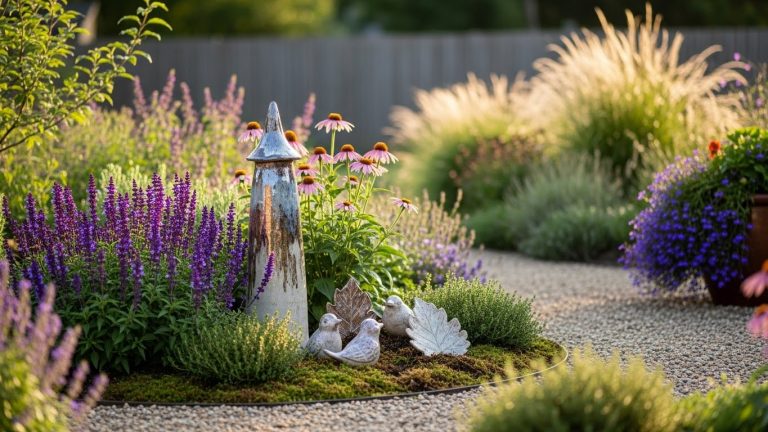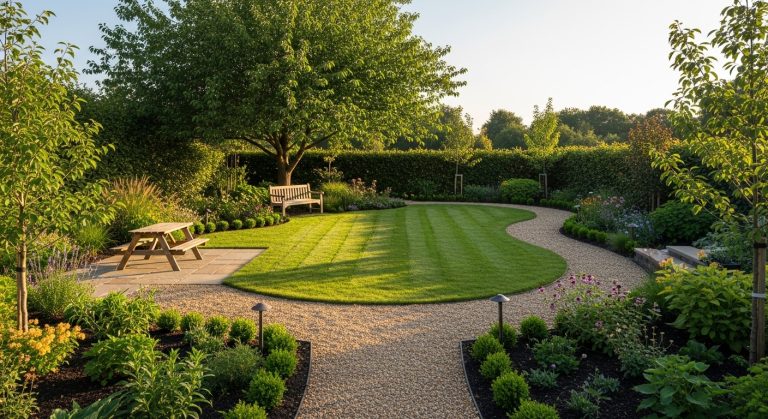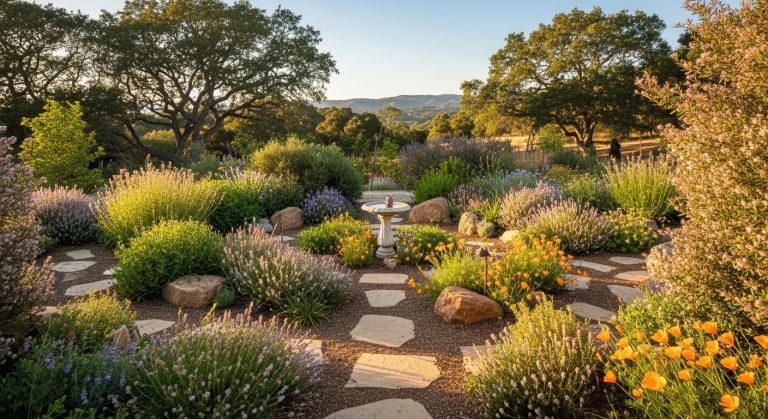15 Stunning Caladium Garden Ideas for Vibrant Shaded Spaces
Ever notice how a single splash of color can completely change the mood of a garden? That’s exactly what caladiums do. I still remember the first time I spotted a neighbor’s front yard bursting with pink, red, and white caladium leaves — it felt like stepping into a living painting. What’s magical is how these tropical beauties bring instant life to shady corners, patios, and even containers, all without demanding hours of care.
Caladiums aren’t just pretty; they’re versatile, adaptable, and surprisingly easy to work into almost any garden layout. Whether you have a cozy balcony, a medium-sized backyard, or a sprawling estate, there’s a way to showcase these colorful foliage stars. Over the years, I’ve experimented with them in borders, container arrangements, layered garden beds, and even alongside water features. The impact is always impressive — vibrant color, visual texture, and a playful rhythm of leaves that changes with the light.
What excites me most about caladiums is their transformative power. A few well-placed bulbs can turn a dull, shaded spot into a focal point that draws the eye, uplifts the mood, and even encourages small wildlife to linger. Below, I’ve collected 15 achievable, visually stunning caladium garden ideas. Each one comes with practical pros, realistic cons, and a small takeaway you can apply immediately to bring your garden to life. These aren’t just theoretical layouts — they’re ideas that I’ve seen succeed in real gardens and are totally doable.
1. Classic Shaded Bed Caladiums

Shaded beds are perfect for caladiums because they thrive out of direct sun. I love how a bed of mixed red, pink, and white caladiums immediately creates a textured, colorful carpet beneath taller shrubs or trees.
Pros
- Brightens shady garden areas without needing blooms.
- Minimal maintenance once planted; only occasional watering and mulch needed.
- Works beautifully as a backdrop for woodland plants like ferns or hostas.
Cons
- Requires a consistently shaded spot.
- Bulbs need lifting in colder climates or mulching for frost protection.
Takeaway: A shaded caladium bed is an effortless way to transform dark corners into vivid, eye-catching areas.
2. Container Caladiums on Patios
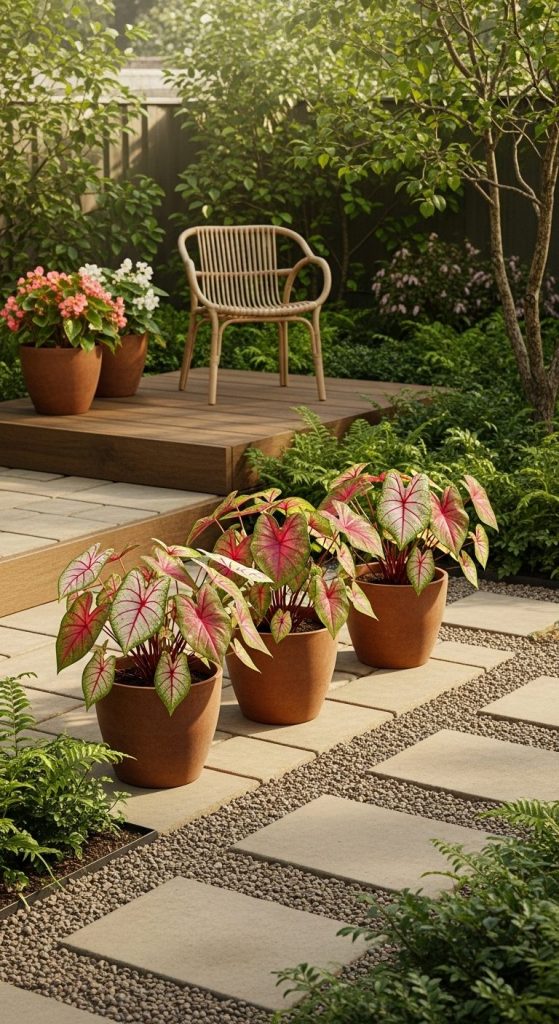
If your space is limited, pots and containers are perfect. I once arranged a trio of caladiums in deep terracotta pots on a small patio, and it instantly felt tropical and inviting.
Pros
- Portable; move for optimal light or to protect from wind.
- Adds visual interest at eye level, especially on small patios.
- Can pair with other container plants like ferns or begonias.
Cons
- Requires regular watering; containers dry out faster than ground soil.
- Pot size can limit foliage growth.
Takeaway: Container caladiums are ideal for renters or anyone seeking instant patio charm.
3. Mixed Caladium Borders
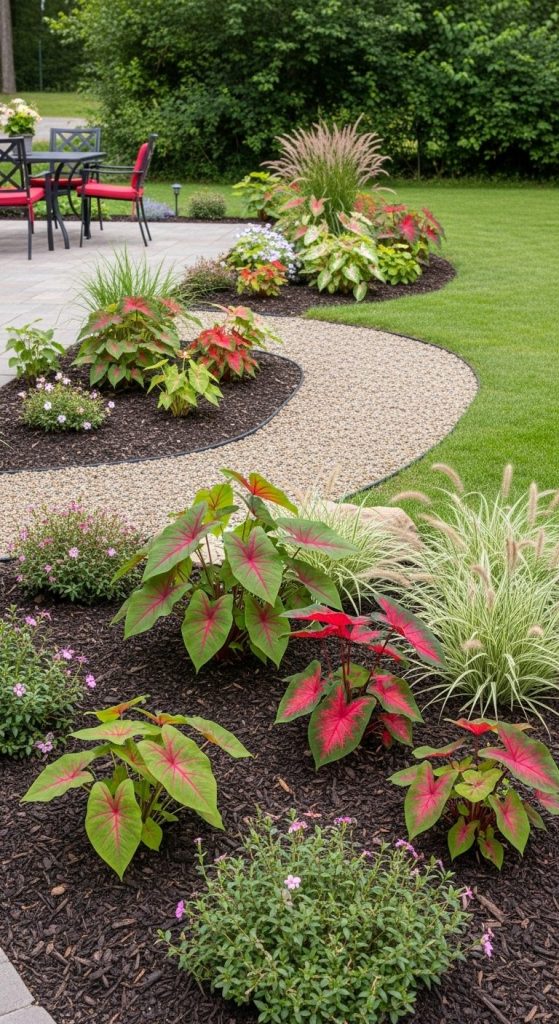
Mixing caladiums along borders creates a lively edge for garden beds. I love pairing green-centered varieties with red or pink leaves to define pathways or property lines.
Pros
- Provides continuous color and texture along garden edges.
- Flexible planting options; fits narrow or wide borders.
- Can be combined with perennials for multi-season interest.
Cons
- Border may need trimming to avoid overlap onto walkways.
- Competition for nutrients with other plants if not spaced properly.
Takeaway: Caladium borders can turn a simple garden edge into a dynamic, layered display.
4. Layered Woodland Caladium Garden
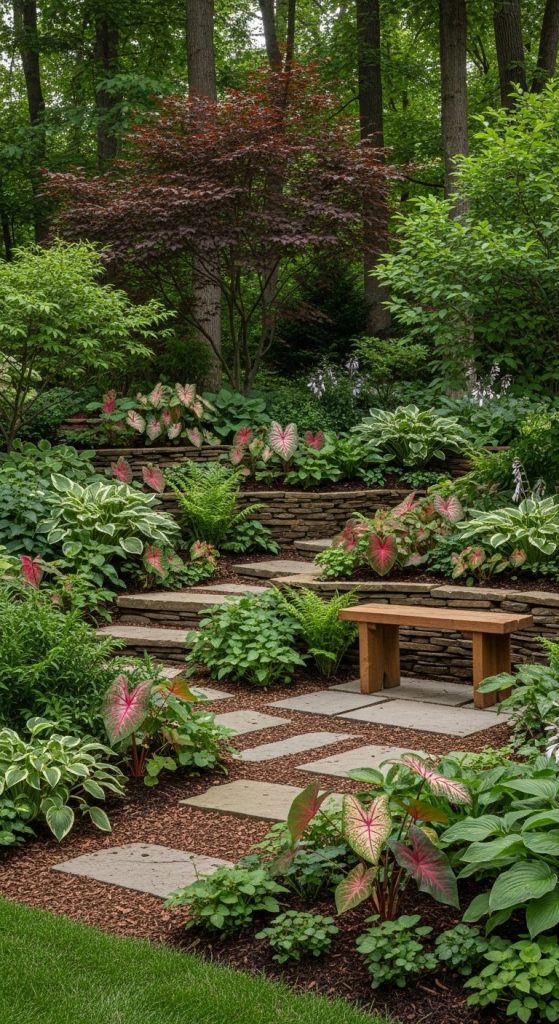
Layering caladiums beneath taller shrubs and trees creates depth and a woodland retreat vibe. I’ve done this with hostas and ferns, and the visual rhythm is almost like a forest floor painting.
Pros
- Adds structure and layered depth to shaded areas.
- Creates naturalistic, low-maintenance zones.
- Encourages insects and small wildlife to explore.
Cons
- Requires planning for plant heights to avoid crowding.
- Bulbs may need periodic division to prevent overgrowth.
Takeaway: Layering caladiums brings a woodland texture and lush, multi-dimensional appeal.
5. Caladium Water Feature Borders
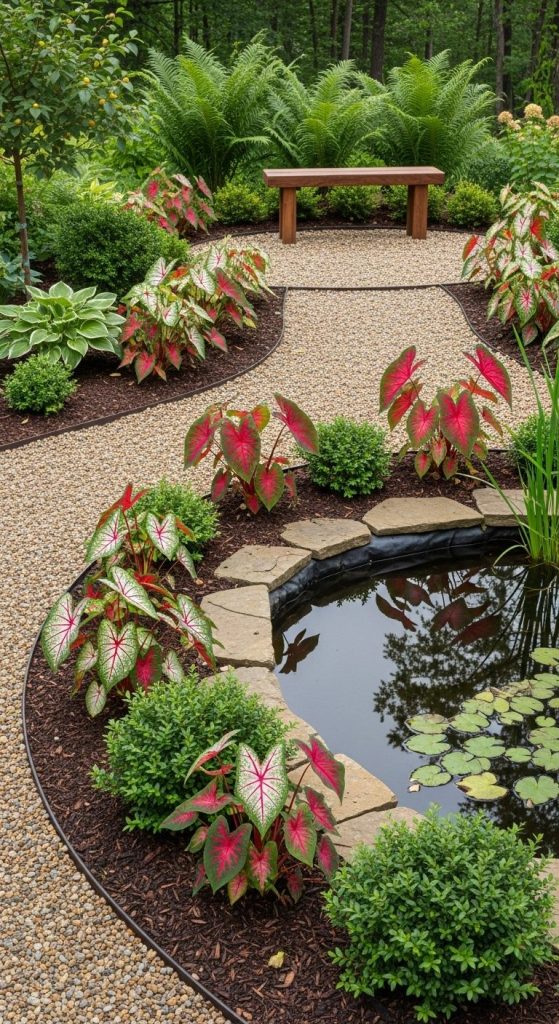
Planting caladiums near small ponds or fountains adds softness and reflective color. I placed them along a backyard stream once, and the reflection of leaves in the water was mesmerizing.
Pros
- Enhances the tropical vibe around water features.
- Softens hard edges of stones and concrete.
- Creates a serene, resort-like atmosphere.
Cons
- Water splashing may occasionally damage leaves.
- Requires well-draining soil to prevent rot.
Takeaway: Caladiums near water naturally elevate the ambiance of fountains or small ponds.
6. Patterned Caladium Beds
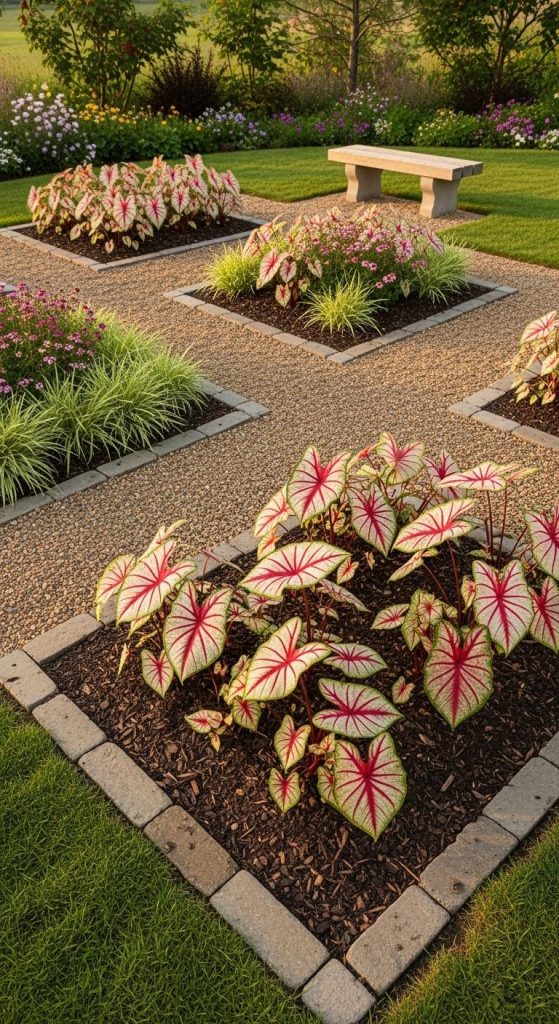
Using caladiums to create patterns — stripes, waves, or color blocks — gives the garden a playful, structured look. I tried a diagonal red and white stripe once, and it drew attention from the street.
Pros
- Visual impact is high; draws the eye immediately.
- Can highlight pathways or garden features.
- Encourages creativity in color combinations.
Cons
- Requires precise spacing and planting.
- More planning and upkeep than casual groupings.
Takeaway: Patterned caladium beds turn ordinary spaces into statement gardens.
7. Caladium and Fern Combo

Pairing caladiums with ferns combines soft, feathery textures with bold leaf colors. It’s an effortless way to add dimension to a shady corner.
Pros
- Textural contrast is visually striking.
- Low maintenance once plants are established.
- Works in naturally shaded or woodland-style gardens.
Cons
- Requires consistent moisture.
- Some ferns may outgrow caladiums if not monitored.
Takeaway: Combining textures with color maximizes interest in small shady areas.
8. Balcony Caladium Arrangements
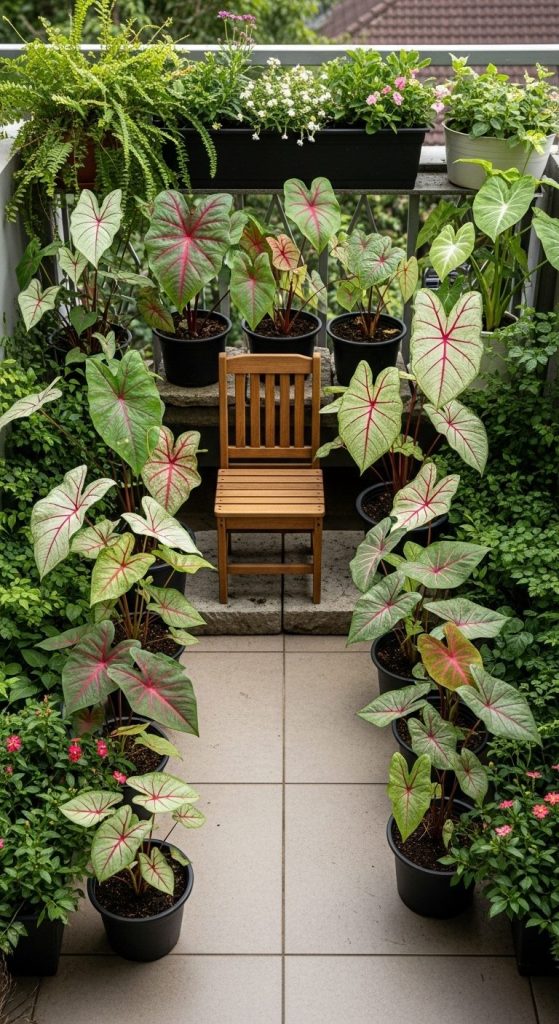
Even apartment balconies can feel lush with caladiums. Grouping pots of different leaf colors and sizes creates a mini tropical escape.
Pros
- Perfect for small spaces; compact and portable.
- Immediate color and greenery boost.
- Flexible design; can move plants seasonally.
Cons
- Needs careful watering to avoid drying out.
- Limited by balcony sunlight exposure.
Takeaway: A balcony arrangement can turn a small urban space into a personal tropical retreat.
9. Seasonal Rotating Caladium Displays
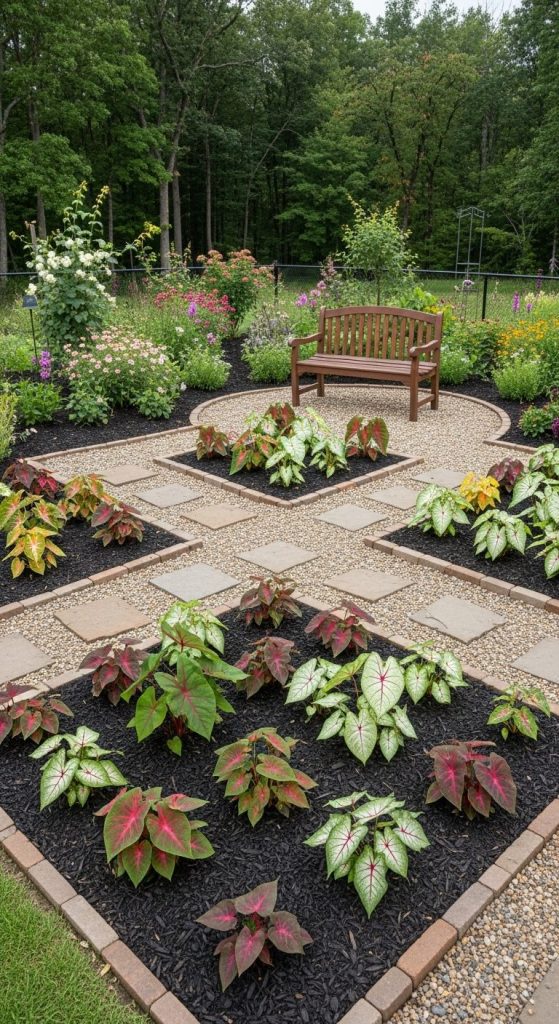
Rotate varieties with changing seasons for a dynamic look. Spring reds, summer pinks, and fall whites keep the garden vibrant throughout the year.
Pros
- Continuous visual interest.
- Encourages experimentation with leaf shapes and patterns.
- Keeps garden dynamic and evolving.
Cons
- Requires planning and seasonal bulb swaps.
- Extra effort for storage in winter climates.
Takeaway: Seasonal rotation ensures the garden never feels static.
10. Caladium Walkway Flanks
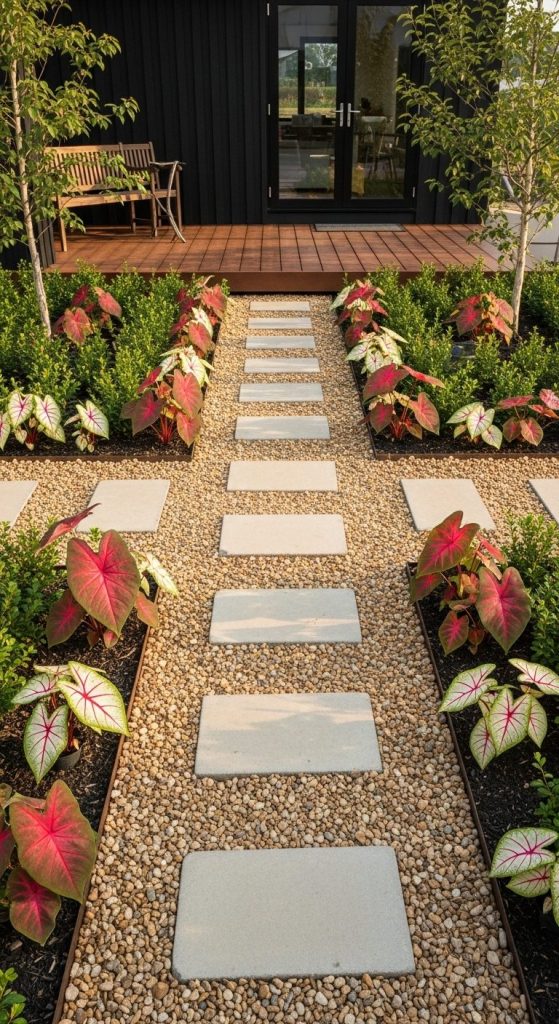
Line pathways with caladiums for a colorful approach to doors or patios. I find that visitors almost always comment on this as soon as they enter.
Pros
- Creates inviting and structured paths.
- Adds immediate visual appeal without complex design.
- Works with stepping stones or gravel paths.
Cons
- Needs pruning to prevent crowding walkways.
- Requires sun/shade planning depending on variety.
Takeaway: Flanking paths with caladiums instantly elevates entrance or garden flow.
11. Mixed Container Towers
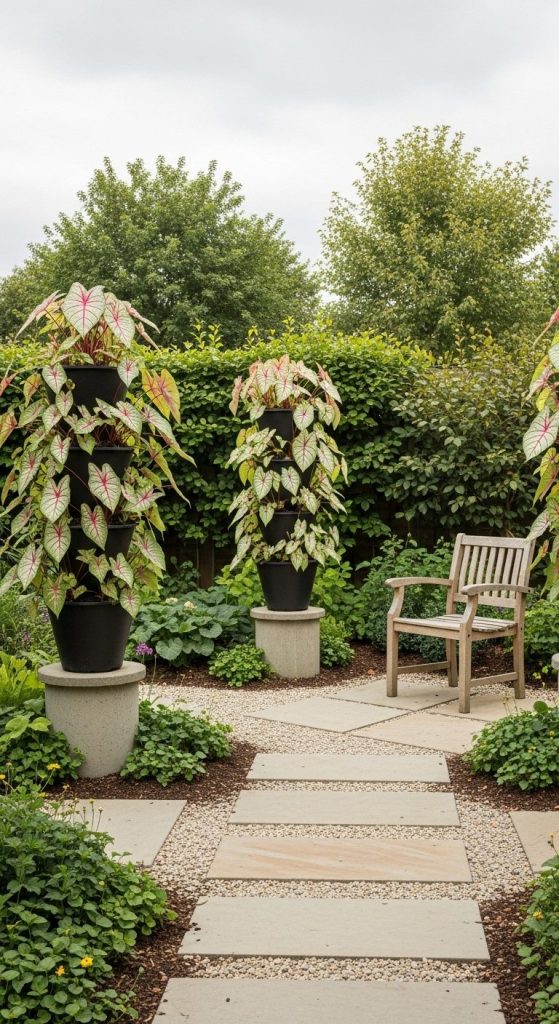
Stacking pots or creating vertical displays with caladiums and other tropical foliage makes small spaces feel full and vibrant.
Pros
- Maximizes color in tight spaces.
- Creates vertical interest for patios or decks.
- Easy to rotate plants seasonally.
Cons
- Requires stable support structures.
- Frequent watering needed for upper pots.
Takeaway: Vertical arrangements amplify visual impact in compact areas.
12. Caladium Edges Around Flower Beds
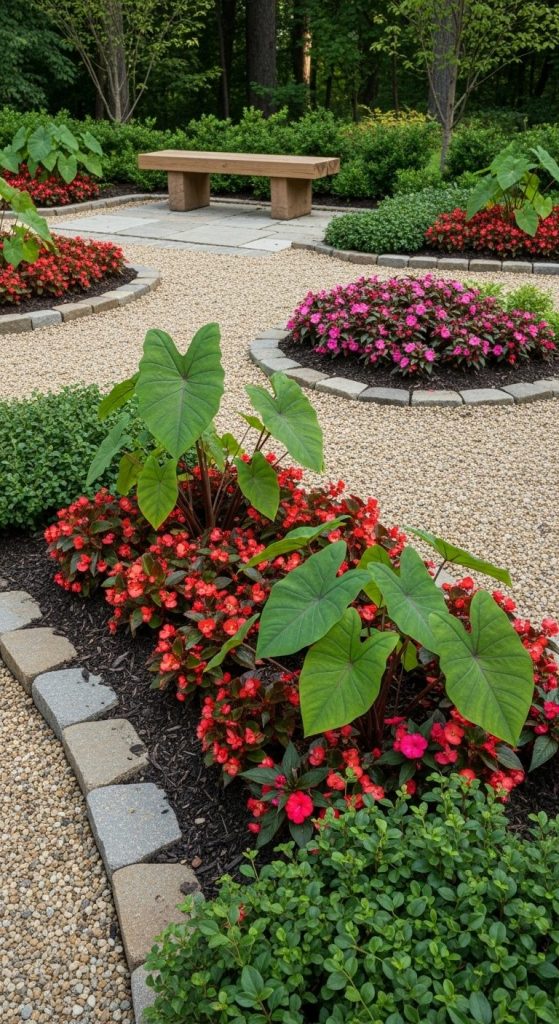
Bordering flower beds with caladiums highlights and frames existing plantings beautifully. The contrast of bold leaves with blooms like begonias or impatiens is stunning.
Pros
- Natural frame enhances garden composition.
- Adds bold texture contrast.
- Flexible; works with almost any flower bed.
Cons
- May compete for nutrients if not spaced well.
- Seasonal dieback requires replanting or bulb storage.
Takeaway: Caladium edges create a finished, professional look with minimal effort.
13. Caladium Mini-Hedge
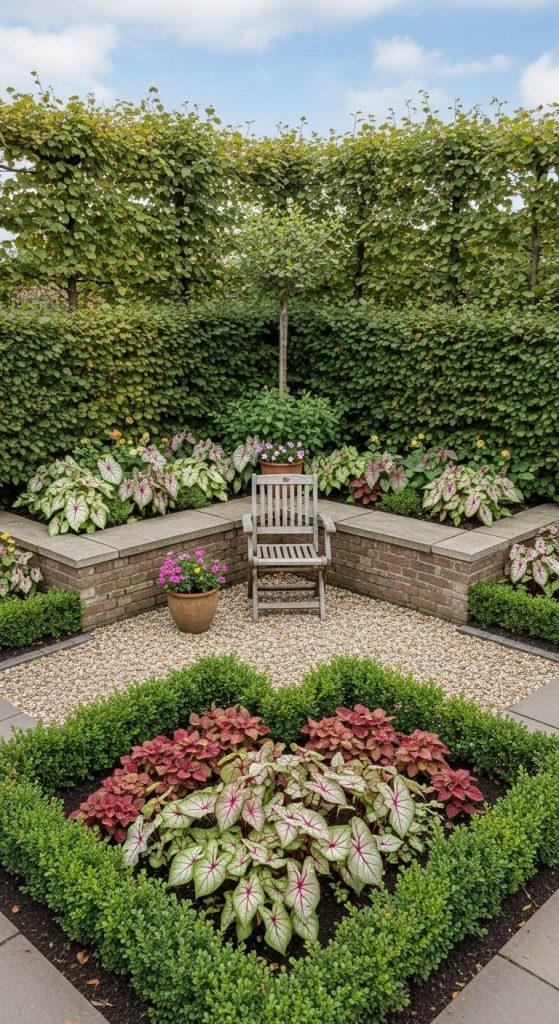
Use dwarf caladium varieties to form low hedges around garden corners or seating areas. I once did this along a small patio, and it felt playful and vibrant.
Pros
- Provides subtle structure without blocking light.
- Adds bright color at low levels.
- Works well with garden furniture as a backdrop.
Cons
- Dwarf varieties may need multiple plants for density.
- Seasonal care includes mulching or bulb storage.
Takeaway: A mini caladium hedge adds both color and subtle garden structure.
14. Tropical Focal Point Clusters
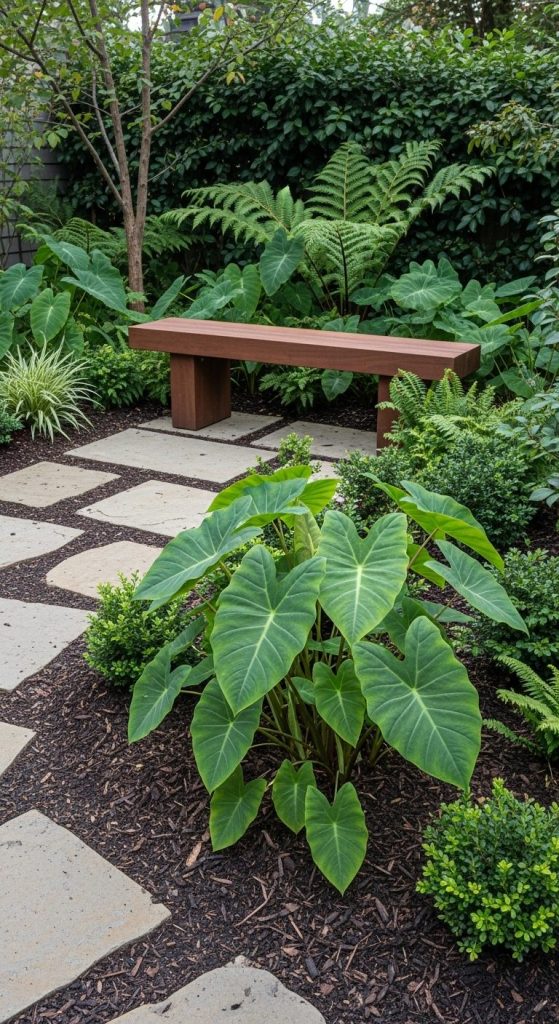
Group large-leaf caladiums in one spot to create a tropical centerpiece. This works well near benches, patios, or fountains.
Pros
- Strong visual focal point.
- Easy to maintain; concentrated care.
- Creates a natural tropical vibe instantly.
Cons
- Concentration of plants may need higher watering.
- Needs space for full leaf expansion.
Takeaway: Focal clusters make a small section feel immersive and lush.
15. Edible Companion Planting

Some gardeners integrate caladiums with shade-loving herbs like mint or chives. The bold leaves provide visual contrast while herbs grow around them.
Pros
- Combines visual interest with practical gardening.
- Can support pollinators visiting herbs.
- Low-maintenance for shaded beds.
Cons
- Some herbs may compete for space or water.
- Caladium bulbs are toxic if ingested; placement matters.
Takeaway: Mixing caladiums with edible companions merges practicality and beauty in shade gardens.
Conclusion
Caladium gardens offer more than just colorful foliage — they’re transformative. From small container arrangements to full shady beds, these tropical leaves add texture, vibrancy, and mood-lifting charm to any space. Personally, I find that layering caladiums with other shade-loving plants creates depth and keeps the garden feeling alive all season. Even one container or a tiny border can make a noticeable difference. Start with a single idea that excites you, observe how the leaves interact with light and neighboring plants, and gradually expand your caladium collection. It’s a simple, effective way to bring a touch of tropical elegance to your yard.

Ashley Ellison is a skilled writer and avid bowler. Her passion for storytelling and dedication to the sport have led her to participate in various national bowling leagues. With a unique combination of talents, Ashley approaches every challenge with creativity and a relentless drive to succeed.

